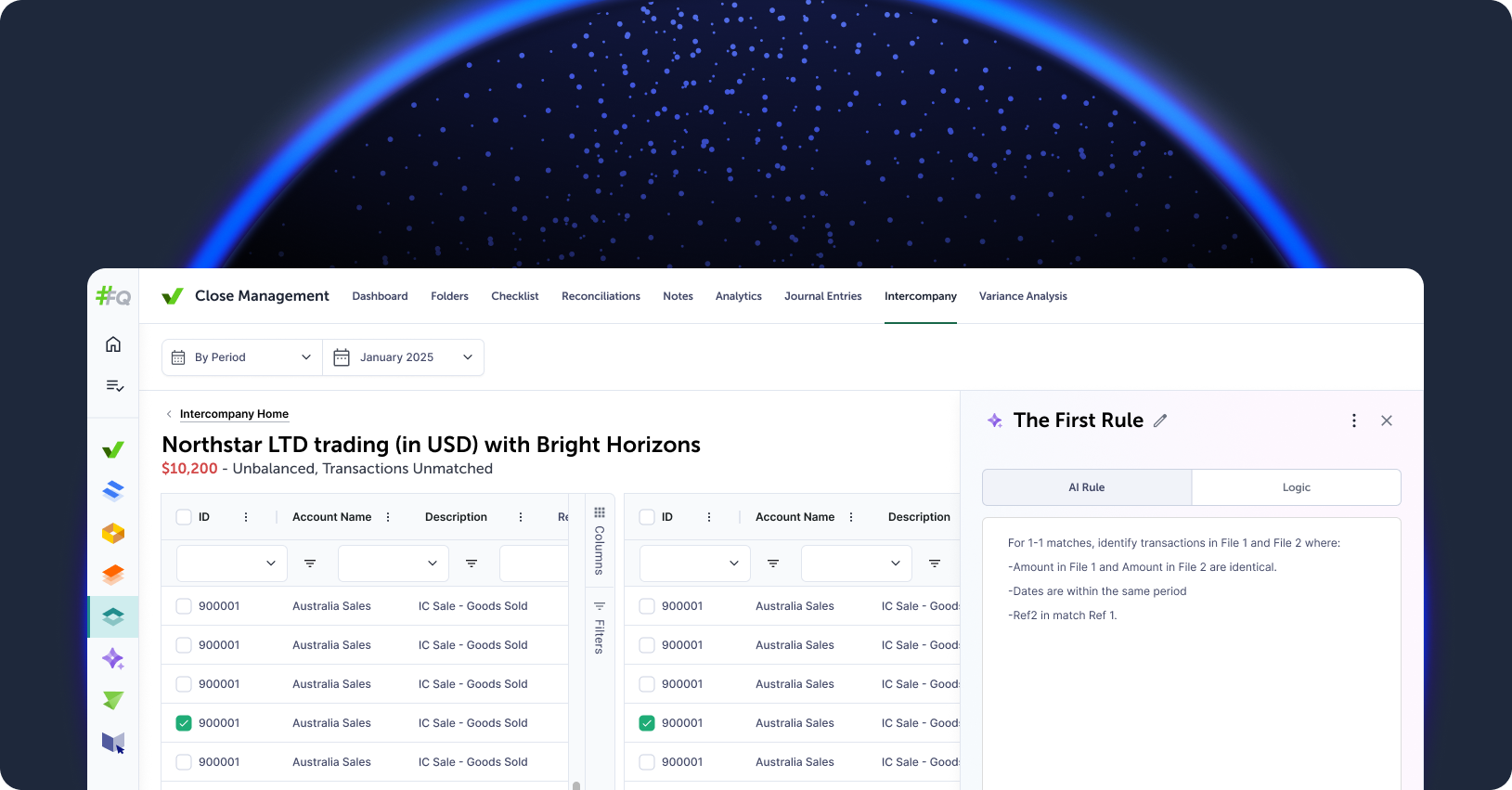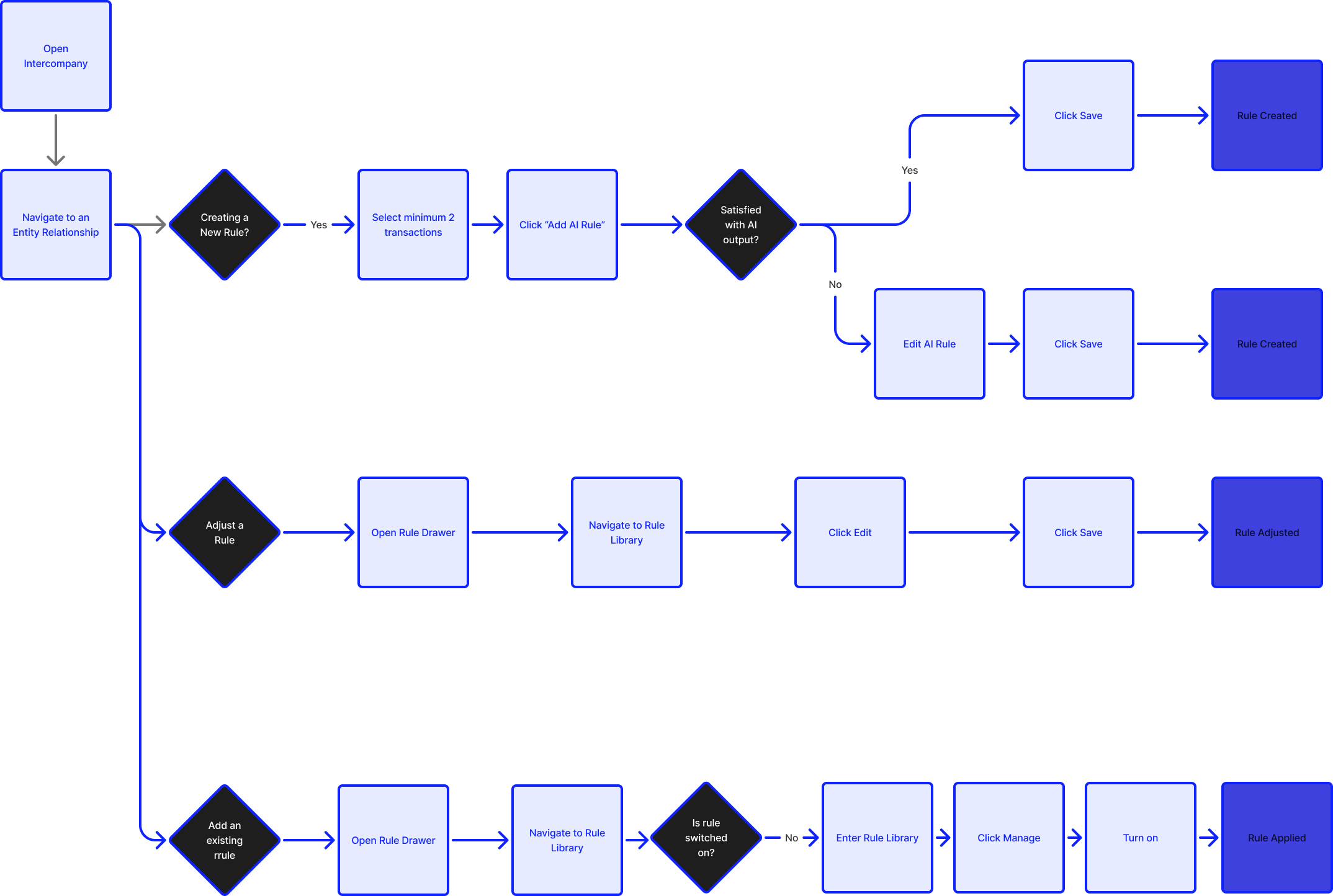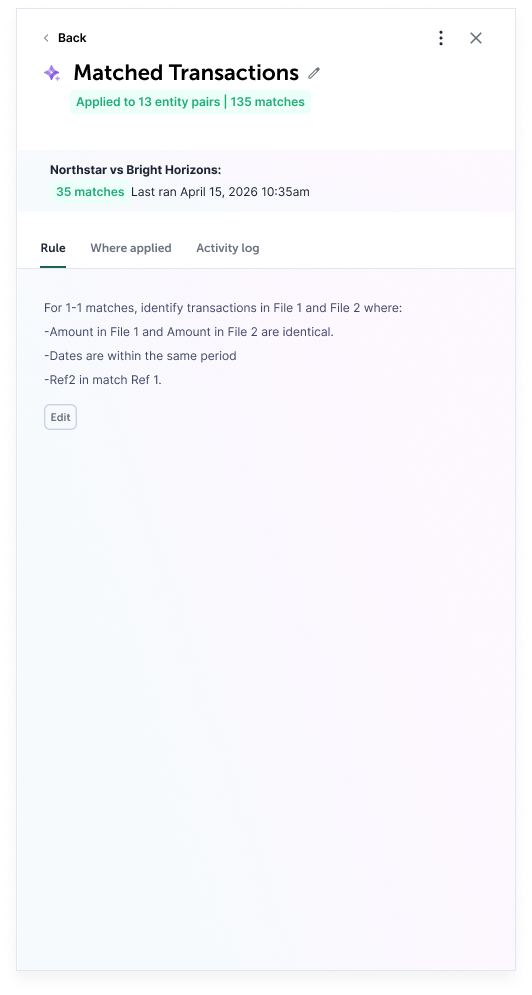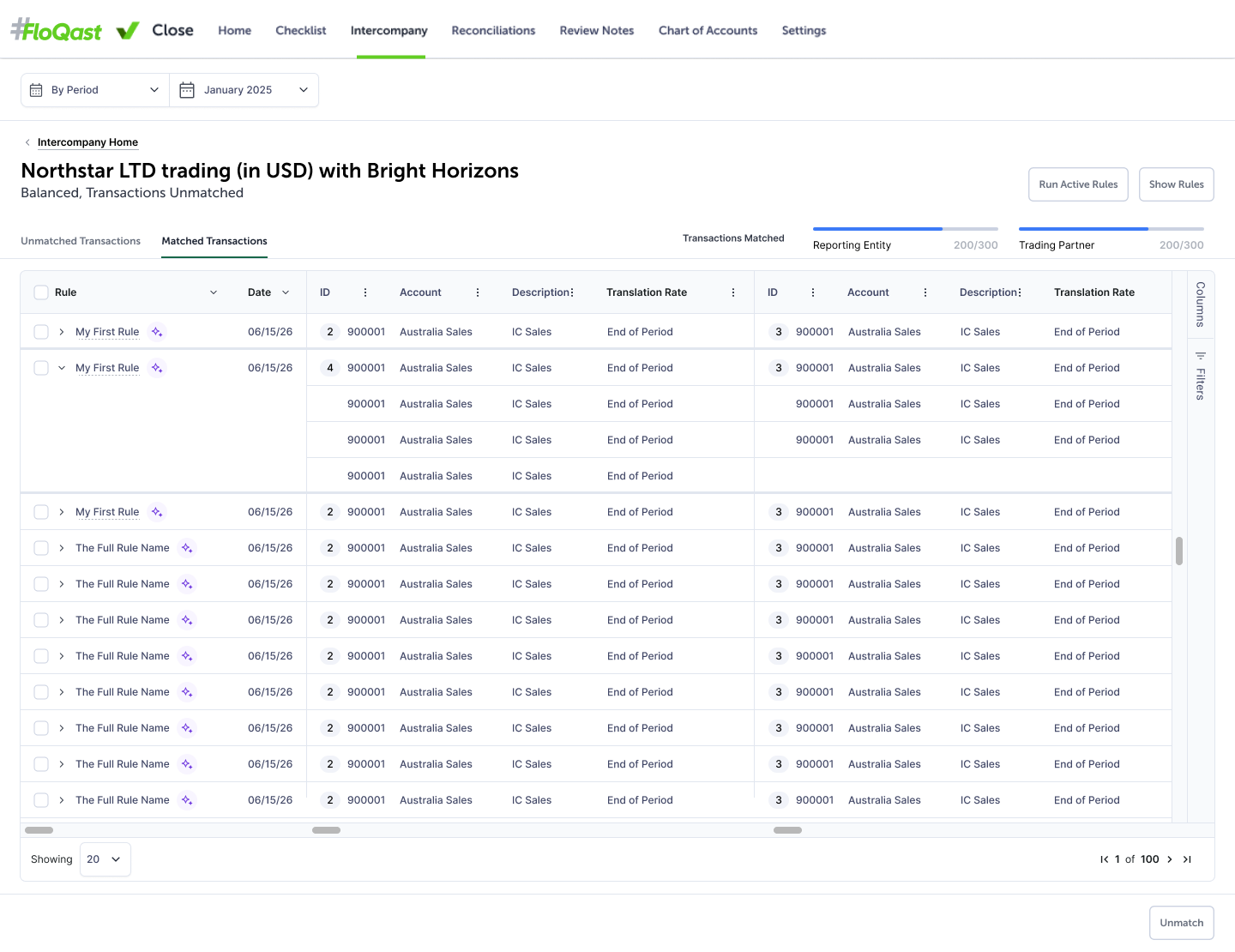A.I.
Fintech Enterprise SaaS
Zero → One
Company: FloQast
AI solution to a tedious accounting process
Introducing AI Matching: Automating Reconciliation for Finance Teams

Context
FloQast is an accounting workflow management system for small to enterprise finance teams, looking to expand to Intercompany Reconciliations as part of the monthly Close process.
Every month, accounting teams ‘close the books,’ a critical process that includes reconciling transactions conducted between different parts of the same company—known as Intercompany Reconciliation. This is often a time-consuming and complex task that clearly demands automation.
Challenge
Monthly Intercompany Reconciliation is a slow, manual, and error-prone process — accountants spend hours matching intercompany transactions — with results far from perfect.
Outcome
Launched an AI-powered matching experience that reduced manual effort by 70% and achieved 68% beta retention.
The Problem
“It takes me over 8 hours to match 800 transactions manually”, a common statement by accountants. And then they still find mistakes.
Research & Insights
9
Interviews
3
Design Partners
4
Usability Sessions
I tested the designs, both as a prototype and in code, with client design partners. Overall, users are looking to complete intercompany matching faster to allow them to shift their attention away from repetitive and manual work and focus instead on more strategic, high-level responsibilities.
The biggest takeaways:
- Manual matching causes time loss and cognitive fatigue.
- Manual matching lacks accuracy, as the data is prone to human error.
- Difficult to identify patterns and problematic areas.
Defining the Opportunity
Business Opportunity
There is an opportunity of appealing to new customers, and also to existing clients — creating meaningful opportunities for up-selling and deeper product adoption. We also have an opportunity to market to large-scale enterprise customers.
There is an opportunity of appealing to new customers, and also to existing clients — creating meaningful opportunities for up-selling and deeper product adoption. We also have an opportunity to market to large-scale enterprise customers.
Product Vision
The overall product vision, which fits in with the entire software as a whole, is that accountants should transition from being preparers to becoming reviewers, allowing them to dedicate more time to strategic, high-value activities.
The overall product vision, which fits in with the entire software as a whole, is that accountants should transition from being preparers to becoming reviewers, allowing them to dedicate more time to strategic, high-value activities.
Design Principles
Trust: users must trust the accuracy of the matches.
Scale: support large datasets with scalable UI patterns.
Cognitive ease: reduce clicks and keep context visible.
Trust: users must trust the accuracy of the matches.
Scale: support large datasets with scalable UI patterns.
Cognitive ease: reduce clicks and keep context visible.
To support ideation, I reformulated the key pain points into 'How Might We' statements.
- ✅ Reduce manual matching effort?
- ✅ Build trust in AI decisions?
- ✅ Design for large-scale data sets?
- ✅ Help identify patterns and areas to improve?
Solution Hypothesis
AI Matching Rules
My hypothesis was to leverage AI to automate the burdensome task of reconciliation—elevating accountants from preparers to reviewers—while accelerating the process. At the same time, I prioritized trust and reliability by building a solution to support thorough review.
My hypothesis was to leverage AI to automate the burdensome task of reconciliation—elevating accountants from preparers to reviewers—while accelerating the process. At the same time, I prioritized trust and reliability by building a solution to support thorough review.
Design Process
Designing with AI
Cross-functional Coordination
As the senior product designer, I guided workshops and discussions with the Product Manager, Engineering Lead, and development team to ensure we were addressing the right problems and prioritizing features and user flows that would deliver the greatest impact.
As the senior product designer, I guided workshops and discussions with the Product Manager, Engineering Lead, and development team to ensure we were addressing the right problems and prioritizing features and user flows that would deliver the greatest impact.
User Journeys
Solutions are only of value when the full journey of the user is understood. My work began with understanding user motivations, and how they would interact with the software.
Solutions are only of value when the full journey of the user is understood. My work began with understanding user motivations, and how they would interact with the software.

✅ Automating matching through the use of AI rules
The idea is to use AI Rules to automatically identify and match transactions that meet predefined criteria, detected by AI and confirmed by the user.


✅ Building trust in AI outcomes
During discovery, we received user feedback that users want to review the work of the AI. This puts them in the role of reviewer (instead of preparer). For this, I created the Matched Tab, where they can see which matches were formed by which rule - and they have the option to un-match if necessary.

✅ Designing for scale
To support large organizations and high-volume data, I designed the system to scale. One key solution was the Rule Library, which allows rules to be shared across entities—eliminating the need to recreate them. Users can view where a rule is active and enable or disable it from any entity.
.png)
✅ Assisting in identifying patterns
Trends are critical, yet the lack of a centralized view makes it difficult to understand the bigger picture or recognize patterns. I designed a holistic view that helps users spot trends, pinpoint problem areas, and identify opportunities for improvement.
Below are designs for the Matrix and List views -- key views for identifying these patterns.
Below are designs for the Matrix and List views -- key views for identifying these patterns.


Continued User Validation
Beta customers reported significant time savings and increased confidence in results. Data from Beta guided subsequent iterations. This included a) users want rules to rollover from period to period, b) users need a way to un-match, c) users wanted tips on improving the AI rules.
Growth Design
AI performance tracker
A dedicated module tracks the performance of AI Matching, showing accountants the impact and value it delivers. It also provides recommendations on how to further improve reconciliation using AI Rules. This demonstrates the benefits of AI Matching and reinforces user adoption and engagement.

Impact
The AI Matching feature transformed a previously manual, error-prone workflow into an automated reconciliation system that scales across multiple entities and accounting teams.
68%
beta retention
70%
reduction in manual matching time
3x
faster month-end close for pilot teams
Operational Efficiency
* Reduced manual reconciliation effort by 70%, freeing accountants from repetitive matching to higher-value review and analysis.
* Cut cycle time from hours to minutes, enabling month-end close processes to start earlier and finish faster.
* Reduced manual reconciliation effort by 70%, freeing accountants from repetitive matching to higher-value review and analysis.
* Cut cycle time from hours to minutes, enabling month-end close processes to start earlier and finish faster.
Business Impact
Supported growth in enterprise accounts with complex intercompany structures, increasing platform stickiness and expansion potential.
Supported growth in enterprise accounts with complex intercompany structures, increasing platform stickiness and expansion potential.
Adoption & Value Realization
* 68% of beta teams signed on for the product — indicating strong perceived value.
* 68% of beta teams signed on for the product — indicating strong perceived value.
Outcome: The feature shifted the user role from data preparer to data reviewer, enabling accounting teams to operate more strategically and positioning FloQast as a system of intelligence — not just record-keeping.
Retro
Tradeoffs
I chose not to implement the logic builder or audit log, or incorporate user permissions for the MVP, as user feedback indicated these are not critical to gain benefit from the product and initial adoption.
Working with Engineering
I maintained ongoing collaboration with the engineering team to understand the limitations of the AI and to adjust the design solution accordingly.
Working with Design Systems
I leveraged existing design system components and consulted with fellow designers to identify any established patterns. Additionally, I developed new design patterns where gaps were identified to ensure a cohesive and effective user experience.
Next Steps
I plan to continue expanding the feature set and enhancing the platform's capabilities, with a strong focus on scalability to meet the needs of enterprise-level customers.
Learnings
- When designing for scale, solutions must accommodate varying use cases and a breadth of data.
- Incorporating AI requires a close, ongoing collaboration with engineering teams to ensure technical feasibility and that performance aligns with the user experience.
- Users consistently emphasize the need for trust and transparency in AI-driven systems, highlighting the importance of auditability.

